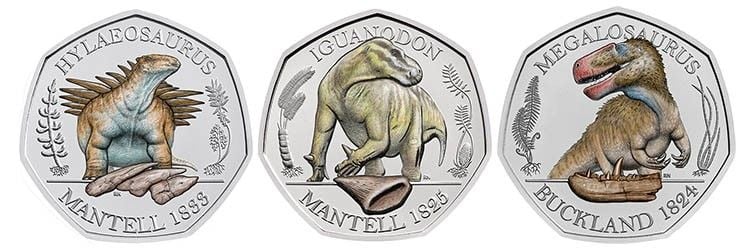Three Ferocious Dinosaurs Featured on New U.K. Coins
Megalosaurus, Iguanodon and Hylaeosaurus were the first dinosaurs to be discovered in modern-day Britain
/https://tf-cmsv2-smithsonianmag-media.s3.amazonaws.com/filer/cf/23/cf2389e8-26b9-47a9-9a1f-2843173496e9/megalosaurus-royal-mint-full-widthjpgthumb19201920.png)
Over the years, the United Kingdom’s 50 pence coin has paid tribute to an array of intriguing figures who have made an important impact on the history of the Great Britain, including the suffragettes, Roger Barrister and Peter Rabbit. But the latest design to come out of the Royal Mint takes inspiration from the nation’s very, very distant history; as Isaac Schultz reports for Atlas Obscura, the institution has announced a series of 50 pence coins depicting three dinosaurs discovered in modern-day Britain.
Millions of years ago, the region now known as Britain was home to an array of dinosaur species. The first three to be found by paleontologists were the Megalosaurus, the Iguanodon and the Hylaeosaurus, which are the three dinos depicted in the Royal Mint’s new collection.
Coins featuring the Megalosaurus, a carnivorous theropod named by the British paleontologist William Buckland in 1824, are already available. According to Sophie Gallagher of the Independent, March will see the release of coins dedicated to the Iguanodon, a large, plant-eating dinosaur named by the paleontologist Gideon Mantell in 1825. The Hylaeosaurus, an armored, quadrupedal herbivore also named by Mantell, will make its appearance on the 50 pence in April.
The dinosaurs featured on the coins played an important role in paleontological history. Megalosaurus, Iguanodon and Hylaeosaurus were discovered at a time when the concept of “dinosaurs” as a group did not yet exist. In fact, it was upon examining fossils of these three creatures that the taxonomist Richard Owen realized he was looking at "a distinct tribe or sub-order” of reptiles—one that he named “Dinosauria” in 1842.

“Owen noticed a number of features of these three animals that distinguished them from all other known reptiles at the time,” explains paleontologist Paul Barrett, one of the experts at London’s Natural History Museum who collaborated on the design. “Critically, one of them was that they had evolved modified hips to deal with their large size and weight.”
“They form the original triumvirate of dinosaurs,” Barrett adds.
The team, which included paleoartist Bob Nicholls, worked with the mint to ensure that the collection was scientifically accurate. Each coin features a depiction of the original fossils from which its dinosaur was described: Hylaeosaurus armour plates, an Iguanodon thumb spike and the Megalosaurus jaw. Experts also sought to reflect recent research into the animals—like the theory that Megalosaurus may have boasted some feathers.
“We brought it up to date by giving it some feathers,” Barrett explains. “But by the same token, we didn’t want to go too far and make it look like some kind of diabolical turkey.”
The coins will be available in gold, silver and base metal, along with two colored versions. They’re legal tender, but they won’t be going into circulation; you can buy them on the Royal Mint’s website for between £10 and £945. Those eager to scoop up an example of the dino-inspired currency would be wise to act fast: Some versions have already sold out.